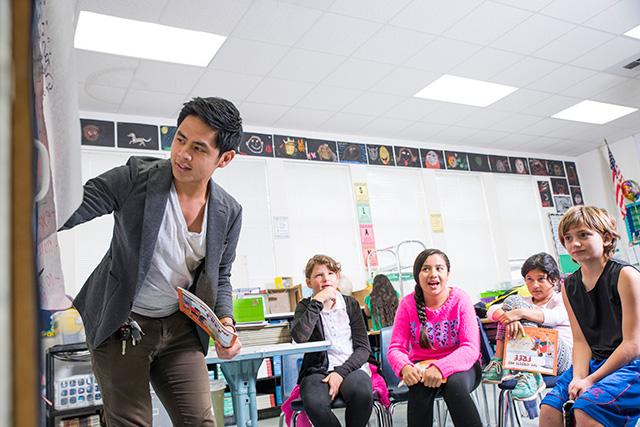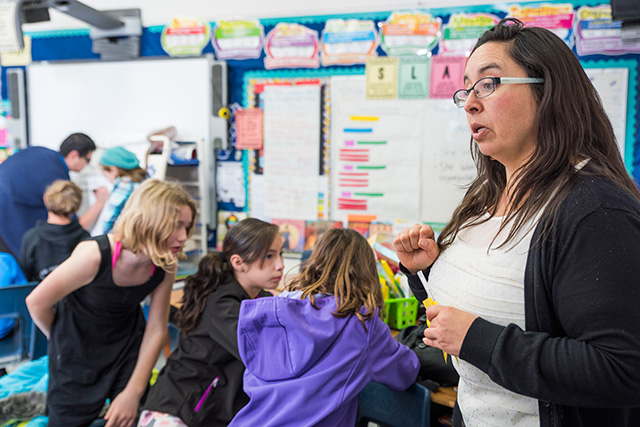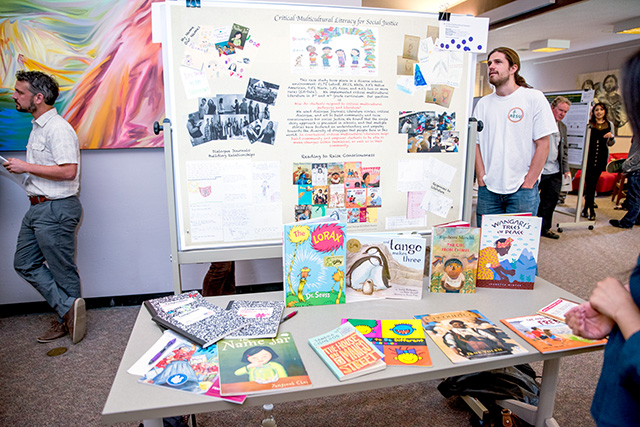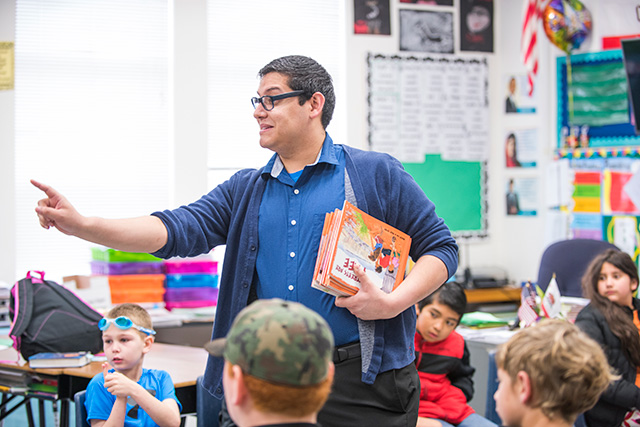
“The book sparked an interest in different lifestyles and what was happening to their peers,” recalls Gabriel Aquino, a Humboldt State Liberal Studies Elementary Education major. “There was no judgment. They were giddy talking about their backgrounds and hearing about how other people live.”
Exposure to diverse perspectives, thoughtful discussion of cultural differences—that’s the point of multicultural education, which students like Aquino have learned to apply in the classroom through an innovative course created last year.
The undergraduate class, Critical Multicultural Children’s Literature, was developed and taught by School of Education Professor Marisol Ruiz. Education students often teach traditional subjects (math, art, science, etc.) in local elementary schools to gain experience. However, Ruiz’s class—a first at HSU—gave students an opportunity to teach multicultural education to children.
The way she sees it, the class is her response to racial incidents and the need for cultural mindfulness in schools.

“I created this class because I heard some students in local community schools were attacked and being called the ‘N’ word,” says Ruiz. “Young kids need to see themselves represented in literature, history, science, and math; to see that the norm is diversity; and to learn to not only respect each other but learn from each other.”
The key to this awareness and understanding, she says, is multicultural education in order to build a path toward a more socially just society.
Education Movement
Born out of the civil rights movement in the 1960s and 1970s, multicultural education incorporates the perspectives of diverse cultures across all disciplines by what’s taught, how it’s taught, and who teaches it.
For students, multicultural education could mean, for example, exposure to children’s literature that tackles topics such as race, class, gender, religion, and abilities. For educators, that could mean including multicultural and social justice instructional materials. And from an administrative perspective, that could mean diversifying staff, administrators, and educators, plus making schools more open and welcoming to the community.
At its heart, multicultural education’s goal is to create a more socially just world for all students, especially historically underrepresented youth, and arming them with critical thinking skills so they can help make the changes they want to see in society.
Berkeley K-12 public schools were among the pioneers and models of multicultural education, long before this form of teaching and learning even had a name, according to Bette Tate-Beaver. The executive director of National Association for Multicultural Education grew up in the Bay Area city during the ‘60s and ‘70s. She recalls teaching that was more flexible and accommodating.

“Teachers understood that not all students learned in the same way and tailored their reading curriculum based on what served the student best. That’s a big part of multicultural education—it’s not just about class, race, and gender. It’s also about teaching to fit different learning styles,” she says.
Today, multicultural education is embraced across the country, says Tate-Beaver. It’s widely used in Connecticut, Nebraska, North Carolina, and most recently, was adopted by Los Angeles Unified School District. In higher education, many universities—HSU included—require a multicultural education course for students pursuing a teaching credential.
Other colleges have devoted entire departments and centers. The University of Washington is one of them. It’s home to the Center for Multicultural Education, founded by James Banks, who is considered the father of multicultural education.
“Multicultural education should be adopted in every college and all schools in the United States. I believe at its core, it’s the key to education reform and teaching our kids well. Marisol and her class are perfect examples of that,” says Tate-Beaver.
From Pedagogy to Practice
For Ruiz, change begins with HSU students. The first few weeks of the course focused on multicultural education pedagogy. From there, they created lesson plans based on a children’s book.
They put their plans to work at South Fortuna Elementary, leading a one-hour discussion in small groups each Friday. Their objective was to encourage children to reflect on their stories and the stories of others.
The books ran the cultural gamut from “And Tango Makes Three,” about two male penguins raising a chick, to “The Name Jar,” about a Korean immigrant who is ashamed of her name.

Skeptical at first, some HSU students were concerned kids wouldn’t be interested in discussing weighty social issues.
Not so, says Smith River Elementary School teacher (Del Norte County), Luis Pelayo. He took Ruiz’s class through HSU’s teaching credential program and is now working closely with her on his master’s thesis. Cultural issues come up, he says, and at the most unexpected moments.
“I presented a word problem in which a girl made more money than a boy,” he recalls of his fourth graders. Some boys didn’t believe he could make less. I told them that in the real world, women make less than men doing the same job. They were shocked and realized it wasn’t fair.
“All of a sudden, a math lesson turned into a discussion on salaries. So no matter what’s taught, it’s important to address social issues right then and there.”